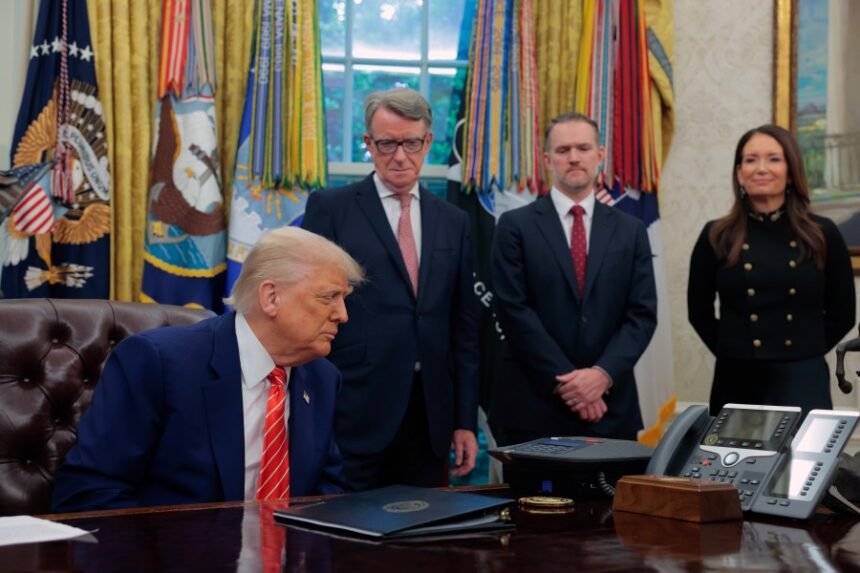Limited Agreement Expands Agricultural Access and Lowers Auto Tariffs, but Major Challenges Persist
U.S. President Donald Trump and British Prime Minister Keir Starmer announced a limited bilateral trade deal on Thursday, marking the first of many anticipated trade agreements aimed at reducing tariffs and boosting economic ties. While the deal has garnered praise for opening up markets and reducing some tariffs, it has left the much-debated 10% tariff on British goods intact, leaving some room for disappointment among stakeholders.
A Modest Beginning
The “general terms” agreement, as described by the two leaders, paves the way for further negotiations, but it does not signal a comprehensive trade overhaul. Instead, it addresses some key areas of trade, particularly in the agricultural and automotive sectors. The deal is part of Trump’s broader strategy to address the U.S.’s $1.2 trillion goods trade deficit by negotiating favourable terms with individual countries. The U.S. president emphasized that this agreement was not a one-size-fits-all template, suggesting that many other nations might face higher tariffs, particularly those with large trade surpluses with the U.S.
“This is a really fantastic, historic day,” said Prime Minister Starmer, referring to the agreement’s symbolic significance, which coincided with the 80th anniversary of the end of World War II in Europe. The deal is seen as a potential boost to job creation and market access for both countries.
Read More: Mattel CEO Doubts Toy Manufacturing Will Return to the US Tariffs, But Price Hikes Are Coming
Key Provisions of the Deal
The U.S.-UK agreement brings several changes to trade dynamics between the two nations. British tariffs on U.S. goods will drop from 5.1% to 1.8%, while U.S. tariffs on British exports remain at 10%. This limited reduction leaves British industries, especially car manufacturers, facing high import duties that could hamper future growth.
Perhaps the most notable change is the reduction of U.S. tariffs on British cars, which will fall from a hefty 27.5% to a more manageable 10%, albeit with restrictions on the number of vehicles eligible for this new rate. The quota for British-made cars will be capped at 100,000 units—roughly the total number of vehicles Britain exported to the U.S. in the previous year.
Additionally, the deal offers reciprocal market access for beef exports, with the UK providing a first-ever tariff-free quota of 13,000 metric tonnes for U.S. beef. This marks a notable shift in agricultural trade relations, although the deal does not bend to U.S. pressure on food standards, particularly regarding U.S. beef treated with growth hormones.
Trade Concerns and Ongoing Negotiations
While both Trump and Starmer hailed the agreement as a breakthrough, British officials have expressed concerns over the absence of any resolution regarding the controversial digital services tax, a 2% levy on online marketplaces in the UK that has drawn criticism from the U.S. Washington has made it clear that the issue could be revisited in future talks, though no specific process has been outlined for these discussions.
“This is not a finished, classic ‘bells and whistles’ free trade agreement,” one UK official remarked, highlighting that the deal began as a response to Trump’s tariffs but has evolved into something more substantial. While this agreement is a step forward, both sides acknowledge that more work remains to be done.
Also Read: Unilateral Tariffs Threaten Global Trade Amid High-Stakes US-China Talks
Economic Impact and Future Prospects
The market’s initial reaction was positive, with the deal helping to fuel a rally on Wall Street. U.S. stock indices surged, and Delta Airlines saw a notable increase in its share price, thanks to the tariff reduction on British-made Rolls-Royce engines. This represents a significant win for U.S. industries, particularly those in the aerospace sector.
Despite these gains, the British-American Business group expressed disappointment at the lack of a comprehensive resolution on tariffs, particularly the 10% duties that continue to burden UK exporters. The group had hoped that this agreement would mark the beginning of deeper economic integration between the two nations, including the digital economy, which remains an area of divergence.
Trump’s administration, under mounting pressure from investors, is keen to strike more deals that can reduce global trade tensions and prevent a slowdown in the economy. According to U.S. Commerce Secretary Howard Lutnick, dozens of similar trade agreements are expected to be rolled out in the coming weeks. These agreements are seen as essential to de-escalating the ongoing tariff war with China, where tariffs on imports between the U.S. and China currently stand at 145% and 125%, respectively.
Trade Wars and the Road Ahead
Looking ahead, Trump faces a complex challenge in resolving the standoff with China, which has led to a virtual trade embargo. Negotiations are set to take place this weekend in Switzerland, where U.S. officials will meet with Chinese counterparts to discuss a path forward. Both sides have indicated that talks will be substantive, but the road to a resolution remains uncertain.
In the UK, Starmer’s government continues to navigate the challenges of post-Brexit trade relations, with the deal with the U.S. seen as an important step toward rebuilding economic ties with key global partners, including China and the European Union.
While the immediate economic impact of this trade agreement may be limited, economists and business leaders agree that the long-term benefits of improved trade relations will likely help boost economic growth and stability in both countries.
Conclusion
The Trump-Starmer deal represents a significant, albeit cautious, step in the evolving landscape of international trade. It offers hope for deeper economic collaboration between the U.S. and the UK, but it also highlights the complexities of navigating tariff disputes and trade demands in a post-Brexit, post-pandemic world.
Click here for more business news.






